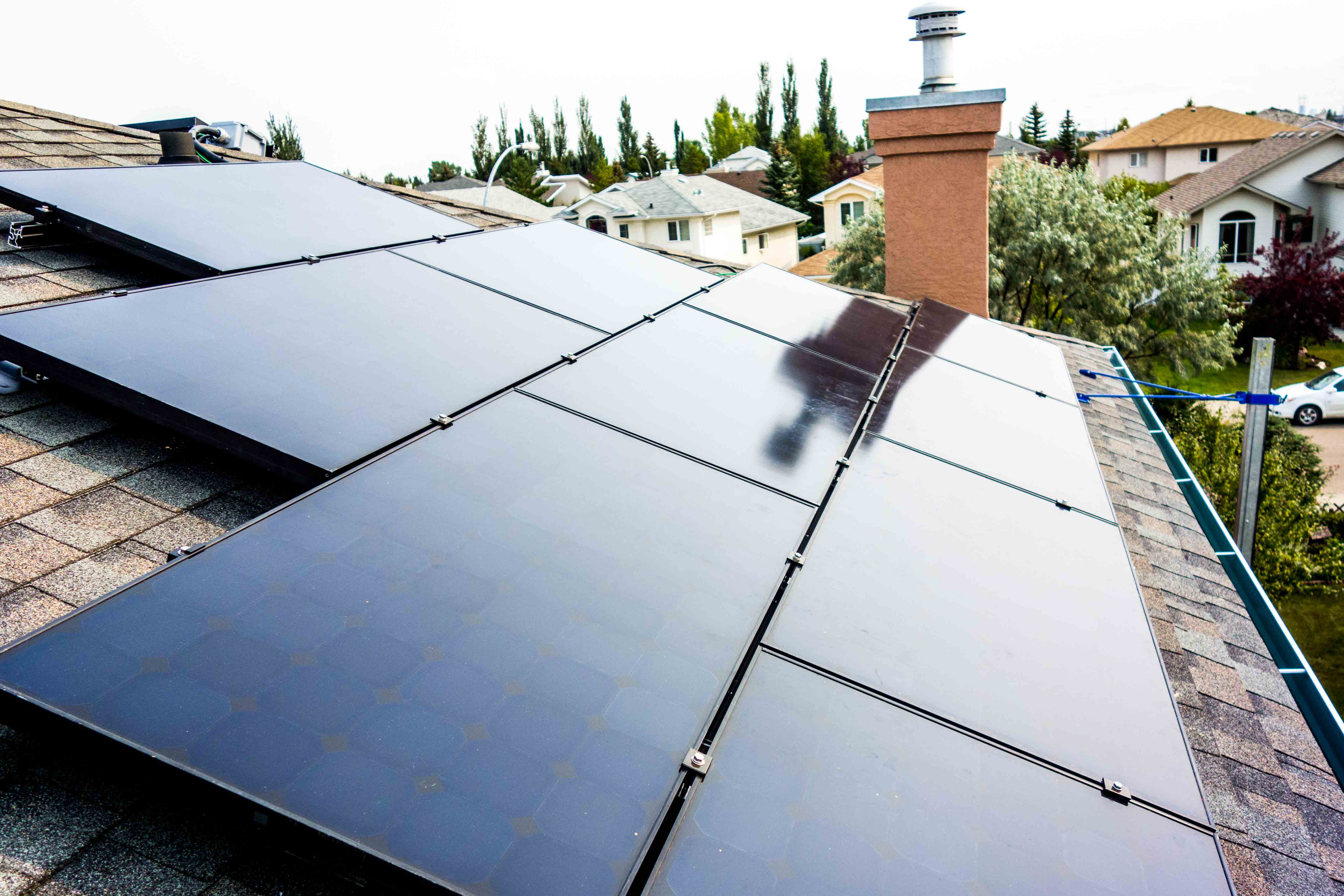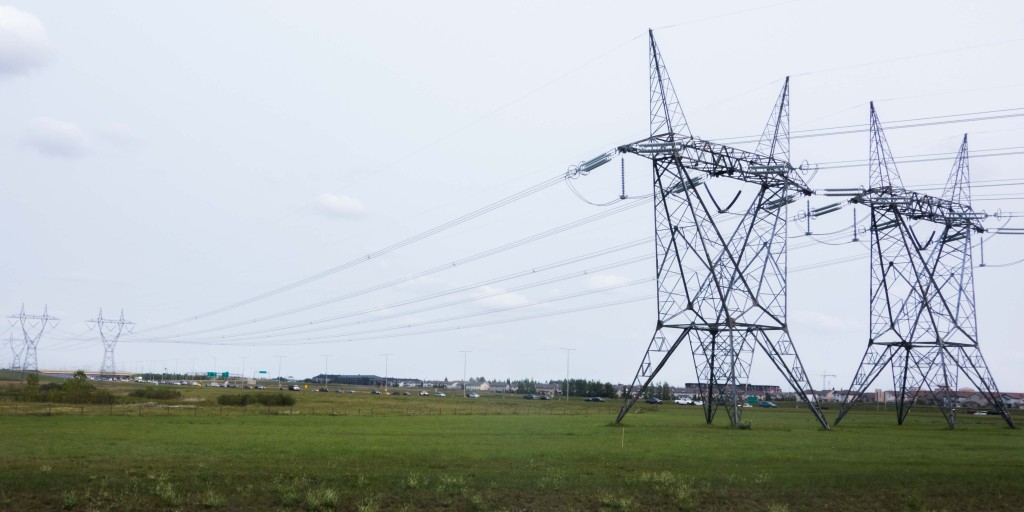
After hearing what Albertans had to say the Climate Change Advisory Panel recommended to the Alberta government that coal fired electricity be phased out by 2030 by phasing in 50-75% of its supply with renewables. Many reports submitted to the Panel advised on how much solar should be installed in the years to come. The Pembina Institute in their report Power to Change, conducted a study where it was shown that four gegawatts (4GW) solar can be connected to the grid whilst phasing out the supply of electricity derived from coal. So we are going to install a lot of solar and of course there are different ways we can develop a transformational capacity.

A transmission line parallel to the Anthony Henday carrying high voltage electricity
Alberta’s solar future
If we wish, we can just build a few giant free-field plants as TransAlta has offered to do, or we can distribute solar over roofs across the province bringing generation – and its assets – closer to the consumer.
It’s too early to justify a target but let us try to imagine how four gigawatts of installed solar will look like. 1GW is equal to one thousand megawatts, and one megawatt (MW) is equal to one thousand kilowatts. Four panels have a rating of about one kilowatt (kW for short, has a total surface area of about 75 squared feet), therefore we are talking about installing around 16 million panels in the next 15 years! About one kilowatt or four panels for every Albertan. These 16 million panels are going to have a total surface area of about 24 squared kilometers, are going to cost us on the order of 10 billion dollars, and are going to produce about 5,000 GWh per year, about 10% of what coal fired plants are supplying today.
Alberta currently has 9.1MW of solar installed, which makes 0.3% of Pembina’s rather conservative target of 4,000MW. The 9.1MW that are currently installed are spread over 1,314 sites(personal communication, Howell-Mayhew Engineering, 2016), which works out an average system capacity of 7kW (28 panels per system). If the average system size installed over the next 15 years is 10kW then we are going to need to install 27,000 systems every year to have a capacity of 4GW by 2030. This may seem unrealistic given our demographics, the number of electricians, inspectors, truck deliveries we are going to need, the number of buildings there are, how much time we have, and so on. So we can expect to see larger ground-mounted installations continuing to supplement rooftop residential and commercial installations that make up the bulk of Alberta’s escalating solar capacity.
Generation vs negative load
Larger systems of course enjoy economies of scale and more cost-effective, centralized technologies. However there are costs that are beyond the installation itself. For example a 500MW solar plant is going to require a transmission system to ship electricity to consumers, and given its size, it can be quite the distance. That transmission system and the local power grid at large also have to be able to handle an extra 500MW of added capacity. On the other hand, accommodating 500MW of solar distributed over thousands of sites spread across a grid that has a baseload of 6,000MW may not be a problem at all.
Connecting a grid-tied solar power system to an existing load is simpler because the wires to the grid are already there. All that is needed (from an accounting point of view only) is a new meter that measures the amount of energy exported from site. Solar is generated right where power is consumed and excess power is back-fed in the existing radial network. For example if a residential grid-tied system is producing more power than the home’s appliances are consuming at any point in time, excess power is transmitted to the neighbour’s home to feed their appliances. The neighbourhood as a whole uses less electricity, which is why electrical engineers can sometimes refer to distributed generation as a negative load. Residential solar has shown to improve real estate value because moving into homes that are going to cost less to live in on the long term is generally a good idea. Ethically speaking, it’s also a good idea since it is transferring capital – which gives power corporations market and political power – to the smaller consumer.
The Panel has recommended we merit projects based on their cost to taxpayers (a clean power call is defined as a reverse auction with bids requiring least cost from tax payers winning.):
Increased renewable generation capacity, with expansion linked to the phase-out of coal, supported by a clean power call through which the government will provide partial, long-term revenue certainty for renewable power at the lowest overall cost to consumers.
Today, small grid-tied systems are provided turn-key for $3 per watt. On the other hand the 2MW ground-mounted installation in Bassano was reported to be installed for $2.4/W. Systems with capacities between 10kW and 2MW will have a price range between these two.
Being innovative
One of the main cost reductions in ground mounted installations is the ability to use 1,000V inverters, which enable more panels to be connected to the same inverter. 1,000V inverters can connect about 70% more panels in series, allowing 40% in wire savings, a 2% improvement in efficiency, and an overall $USD 0.1/W reduction in system hardware costs (not including savings on labour). Europe has allowed 1,000V DC systems on homes and shops since 2013, however in Canada there’s still a lot of work to be done. Coming up to standard on this topic can be a huge benefit to the development of distributed solar.
Installing a residential system on several different roof areas may have a lower output, increased labour and capital costs, but it also allows installers to be creative. The bigger the installation, the more repetitive and specialized the job tasks become. It might be more interesting for a project manager but for the most part on larger jobs, installers are typically hired temporarily and work in assembly lines which exposes them to one part of the project with rather menial job tasks. The smaller the average installation, the more installations there are, the more creative installers have to be, the more there is to learn, and so the quality of training is higher.
Beyond the best bang for the buck
So we are going to install lots of solar in Alberta. What kind of jobs do we want to create for Albertans? What kind of training are these jobs going to be providing? Are we making the best of the technology that is available? Where are the millions of solar panels going to come from? Who is going to own these solar assets?
As mentioned the opportunity of going solar is a way for consumers to turn into micro-generators of renewable energy. They protect homes, businesses, churches, schools, communities, and co-op members, from the costs and risks of fossil fired electricity. Solar – together with wind – can sustain Alberta’s legacy as an energy provider and, if done carefully, as a technology provider as well.
[author title=”About the Author”]